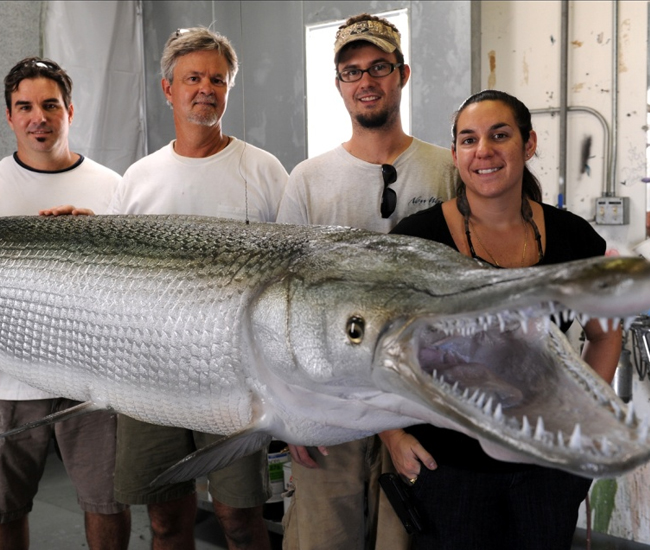
A much-feared freshwater fish that grows longer than a horse and has a mouth like a crocodile is being embraced by biologists and ecologists in the US as the last hope of controlling a damaging invasion of Asian carp, which has swept up the country’s waterways towards the Great Lakes like an unstoppable tide.
Once prevalent in rivers ranging from the Gulf of Mexico to Illinois, the alligator gar has a freakishly ferocious appearance, growing up to three metres in length, weighing as much as 150kg, with a body covered in tough spiky scales and boasting a giant gob bristling with two rows of needlelike teeth—it’s like the aquatic version of the Gruffalo.
Native Americans reportedly used their enamel-like scales as arrow points, and early settlers coated their plough blades with the fish’s skin and scales, but in modern times anglers turned against them, believing they were a ‘trash fish’ wiping out prized sport species, and they were targeted for extermination, with hunters using guns and even dynamite to wipe them out. Declared extinct in many states, the alligator gar survived only in the waterways of the deep south, along the tributaries of the Mississippi River and around the Gulf of Mexico.
‘Some horrible things have been done to this fish,’ Allyse Ferrara, an alligator gar expert at Nicholls State University in Louisiana, told the Washington Post. ‘It’s similar to how we used to think of wolves; we didn’t understand the role they played in the ecosystem.’

Now, however, scientists and fishing folk have come to the realisation that the gar might be the lethal weapon they need to combat the influx of invasive Asian carp, which themselves can grow to over a metre and weigh 45kg or more, and an attempt is underway to reintroduce the species from Illinois to Tennessee.
‘What else is going to be able to eat those monster carp?’ asks Ferrara. ‘We haven’t found any other way to control them.’
Missouri state fish ecologist and President-elect of the American Fisheries Society, Quinton Phelps, agrees, claiming the only way to effectively control carp is when they’re smaller, before they can spawn, which is when the gar would pick them off. ‘There is potential for them to be a wonderful weapon,’ he said. ‘But it’s just potential right now.’

Not everyone is so enthusiastic, however. Some fishing groups still deride the gar as a ‘trash fish’, and others worry that the predator would attract trophy hunters who might kill the reintroduced fish before they’ve had a chance to reach spawning age.
‘It will be interesting to see if fishermen have enough integrity to pass up a 7-foot fish that’s 200 pounds,’ Christopher Kennedy, a Missouri fisheries supervisor who’s working on catch regulations, told the Post. ‘We’d love to create a self-sustaining population that we can turn into a trophy fishery.’
Either way, the alligator gar looks set to make a triumphant return to the waterways of North America, with stocks of the fast growing fish already being bred and raised in lakes in Illinois. And anglers such as Olaf Nelson, who in 2013 became the first person to catch an alligator gar in Illinois in 50 years, are welcoming the move.
‘Whether they’re loved or hated, they’re a natural part of the Illinois ecosystem,’ he said. ‘It’s pretty rare that we can fix a mistake.’
[geoip-content not_country=”CA”]
ON THE APP
 Drain the Great Lakes
Drain the Great Lakes
North America’s Great Lakes are the largest system of freshwater on Earth, but what would we discover if all the water were suddenly to disappear? Go back in time to explore the unseen geological treasures and lost human history that have been hidden beneath North America’s huge lakebeds since the last Ice Age.
Want to watch Drain the Great Lakes for free right now? Subscribe to the Love Nature streaming app and start your 30-day free trial of the best on-demand natural history documentaries out there. [/geoip-content]

